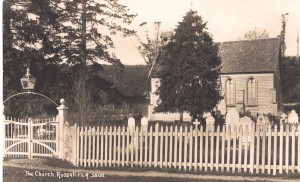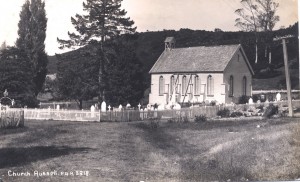History
(Photograph courtesy Russell Museum – taken in the late 1860s)
Our church is the oldest existing church in NZ today, and possibly the oldest building still used for its original purpose.
Its beginnings go back to the earliest years of Maori European contact in the Bay of Islands when missionaries from across the harbour at the Paihia mission station rowed across to take services in private homes.
Russell, then known by its original Maori name of ‘Kororareka’ was a rough seaport, popular with Pacific whalers, with the nickname ‘The Hellhole of the Pacific’.
The missionaries purchased land in 1834 from Kororareka chiefs Rewa, Wharerahi and Moka and agreed that Maori and Pakeha (Europeans) should have equal rights of burial.
The fundraising subscription list for the church survives with names of missionaries, settlers, traders and ships’ captains including ‘Captain Fitzroy, Mr. Charles Darwin and officers of HMS Beagle’. The building began in 1835 and a simple rectangular chapel with hipped roof was constructed.
According to official records, the first service was on 3 January 1836 when William Williams from Paihia mentions taking one in the ‘new chapel’. Services were conducted in both English and Maori languages.
Dr Broughton consecrated the burialground around the church in 1839.
On 30 January 1840 Captain William Hobson used the church to make three proclamations.
The first was to announce the extension of the boundaries of New South Wales to include the islands of New Zealand. The second was in relation to his own appointment as Lieutenant Governor of NZ, with the third relating to land transactions (and notably the issue of pre-emption). A document recording what had occurred was drafted and signed by 41 witnesses, including a number of settlers, missionaries, and the chief Moka Te Kainga-Mataa (being the sole Maori signatory). Following this event all other occurrences in relation to the Treaty of Waitangi, including the meeting and its signing, occurred across the bay at Waitangi on 5 and 6 February. The church was also used occasionally as a courthouse.
Reverend Robert Burrows was the first resident clergyman living in a vicarage on the hillside above the church. On 11 March 1845, during the Battle of Kororareka between British forces and Maori dissatisfied with British rule, the church was hit by stray musket and cannon balls, evidence still visible today.
In 1871 the church was altered to its present shape with V roof, buttresses, a gallery, porch and belfry, and two years later received its name.
(Photograph courtesy Russell Museum)
By the early 20th Century the church was in a shaky condition so props were set up each side to support it for a time. It was served by vicars based at Kawakawa and from 1953 onwards, Kerikeri.
(Photograph courtesy Russell Museum – taken about 1917)
The church celebrated its centennial in 1936 with an outdoor service, and in 1963 welcomed Queen Elizabeth II and Prince Philip.
In 1986 the church marked its 150th birthday in the presence of the then Governor General, Sir Paul Reeves and Prime Minister David Lange.
In 2000 Christ Church was extensively restored and today continues to draw a constant stream of visitors who enjoy its sense of history, its tranquility and its wairua (spiritual atmosphere).
Among the graves in the churchyard are those of Tamati Waka Nene (a Ngapuhi chief largely responsible for the Maori’s acceptance of the Treaty of Waitangi and who fought for the settlers against Hone Heke), Hannah King Letheridge (now known to be the second European girl to be born in NZ), Dr Samuel Ford (the country’s first resident surgeon), members of the Clendon family (James R Clendon was the first honorary United States Consul), the men from HMS Hazard who fell in the battle, and a number of whalers whose headstones often tell of untimely deaths.
People from all countries find a walk around the churchyard fascinating, as they see links with their past. The congregation recognises they have a significant ministry to tourists, and welcome people from all over the world to services.



